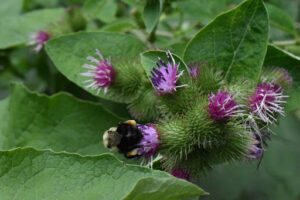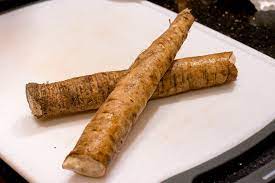Written By: Liam Statham
Edited By: Nehaa Kousihan
Designed By: Maahi Jain
Published By: Tvisha Lakhani

Photo of Burdock
If you’ve been gardening or visiting parks in the last couple years, you have likely encountered burdock root.
Identified by its large, way-edged leaves and its annoyingly sticky purple flowers, burdock is an invasive plant that’s been taking over many gardens and parks in Ontario. But beyond its invasive tendencies, burdock root is capable of serving a culinary role too. Burdock root can be consumed in a wide range of ways, and given its potential health benefits, it may be beneficial for us to look into how we can utilize burdock in our diet.
How Can Burdock Be Used?
Much of the burdock plant can be used in one way or another, but the leaf stem, flower stalk, and root are the most popular. The leaves are technically edible, but most say that they are way too bitter to be enjoyable.
The Leaf Stem: The leaf steam of burdock has a mild taste, and a texture similar to celery. It can be eaten raw or added into hot dishes like soups or stir frys.
 The Flower Stalk: The flower stalk is similar in taste and texture to the leaf steam except that it’s sweeter. It can be eaten raw or simmered until they’re tender and then frying them in butter.
The Flower Stalk: The flower stalk is similar in taste and texture to the leaf steam except that it’s sweeter. It can be eaten raw or simmered until they’re tender and then frying them in butter.
The Root: This is the most popular edible part of burdock. It is very common in Japan to use it in soups or tea. Just like the leaf stem, it can be eaten raw but also works great in hot dishes.
What are the Health Benefits of Burdock?
Burdock root boasts many health benefits. These include:
– Removing toxins from the blood
– Treating skin issues
– Providing the body with antioxidants
– Possibly inhibiting some types of cancer. Studies have shown that burdock had “potent inhibitory effects” on certain types of cancer growths. Learn more here.
Conclusion
In conclusion, while burdock is an invasive plant that puts many native plant species in danger, its health benefits and practical use in the kitchen make it an interesting subject for consideration. As we navigate its intricate duality, informed decisions can guide us to a more sustainable coexistence with burdock and other invasive species.
Works Cited
Gotter, A. (2023, February 21). What is burdock root?. Healthline. https://www.healthline.com/health/burdock-root#benefits
Burdock. Mount Sinai Health System. (n.d.). https://www.mountsinai.org/health-library/herb/burdock#:~:text=Burdock%20contains%20inulin%2C%20a%20natural,properties%20that%20could%20improve%20health.
Four Season Foraging. (2022, February 9). Burdock: It’s more than just burs. Four Season Foraging. https://www.fourseasonforaging.com/blog/2019/11/1/burdock#:~:text=For%20edible%20and%20medicinal%20purposes,are%20consistently%20bitter%20beyond%20belief.
Bob Hartzler, Meaghan Anderson (n.d.). Common burdock. Common burdock | Integrated Crop Management. https://crops.extension.iastate.edu/encyclopedia/common-burdock
Images
TJ on Unsplash
Fitkitchen on Flickr

